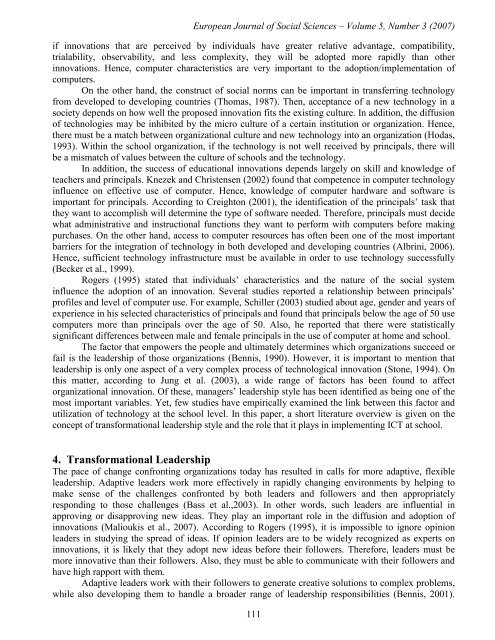european journal of social sciences issn: 1450-2267 - EuroJournals
european journal of social sciences issn: 1450-2267 - EuroJournals
european journal of social sciences issn: 1450-2267 - EuroJournals
Create successful ePaper yourself
Turn your PDF publications into a flip-book with our unique Google optimized e-Paper software.
European Journal <strong>of</strong> Social Sciences – Volume 5, Number 3 (2007)<br />
if innovations that are perceived by individuals have greater relative advantage, compatibility,<br />
trialability, observability, and less complexity, they will be adopted more rapidly than other<br />
innovations. Hence, computer characteristics are very important to the adoption/implementation <strong>of</strong><br />
computers.<br />
On the other hand, the construct <strong>of</strong> <strong>social</strong> norms can be important in transferring technology<br />
from developed to developing countries (Thomas, 1987). Then, acceptance <strong>of</strong> a new technology in a<br />
society depends on how well the proposed innovation fits the existing culture. In addition, the diffusion<br />
<strong>of</strong> technologies may be inhibited by the micro culture <strong>of</strong> a certain institution or organization. Hence,<br />
there must be a match between organizational culture and new technology into an organization (Hodas,<br />
1993). Within the school organization, if the technology is not well received by principals, there will<br />
be a mismatch <strong>of</strong> values between the culture <strong>of</strong> schools and the technology.<br />
In addition, the success <strong>of</strong> educational innovations depends largely on skill and knowledge <strong>of</strong><br />
teachers and principals. Knezek and Christensen (2002) found that competence in computer technology<br />
influence on effective use <strong>of</strong> computer. Hence, knowledge <strong>of</strong> computer hardware and s<strong>of</strong>tware is<br />
important for principals. According to Creighton (2001), the identification <strong>of</strong> the principals’ task that<br />
they want to accomplish will determine the type <strong>of</strong> s<strong>of</strong>tware needed. Therefore, principals must decide<br />
what administrative and instructional functions they want to perform with computers before making<br />
purchases. On the other hand, access to computer resources has <strong>of</strong>ten been one <strong>of</strong> the most important<br />
barriers for the integration <strong>of</strong> technology in both developed and developing countries (Albrini, 2006).<br />
Hence, sufficient technology infrastructure must be available in order to use technology successfully<br />
(Becker et al., 1999).<br />
Rogers (1995) stated that individuals’ characteristics and the nature <strong>of</strong> the <strong>social</strong> system<br />
influence the adoption <strong>of</strong> an innovation. Several studies reported a relationship between principals’<br />
pr<strong>of</strong>iles and level <strong>of</strong> computer use. For example, Schiller (2003) studied about age, gender and years <strong>of</strong><br />
experience in his selected characteristics <strong>of</strong> principals and found that principals below the age <strong>of</strong> 50 use<br />
computers more than principals over the age <strong>of</strong> 50. Also, he reported that there were statistically<br />
significant differences between male and female principals in the use <strong>of</strong> computer at home and school.<br />
The factor that empowers the people and ultimately determines which organizations succeed or<br />
fail is the leadership <strong>of</strong> those organizations (Bennis, 1990). However, it is important to mention that<br />
leadership is only one aspect <strong>of</strong> a very complex process <strong>of</strong> technological innovation (Stone, 1994). On<br />
this matter, according to Jung et al. (2003), a wide range <strong>of</strong> factors has been found to affect<br />
organizational innovation. Of these, managers’ leadership style has been identified as being one <strong>of</strong> the<br />
most important variables. Yet, few studies have empirically examined the link between this factor and<br />
utilization <strong>of</strong> technology at the school level. In this paper, a short literature overview is given on the<br />
concept <strong>of</strong> transformational leadership style and the role that it plays in implementing ICT at school.<br />
4. Transformational Leadership<br />
The pace <strong>of</strong> change confronting organizations today has resulted in calls for more adaptive, flexible<br />
leadership. Adaptive leaders work more effectively in rapidly changing environments by helping to<br />
make sense <strong>of</strong> the challenges confronted by both leaders and followers and then appropriately<br />
responding to those challenges (Bass et al.,2003). In other words, such leaders are influential in<br />
approving or disapproving new ideas. They play an important role in the diffusion and adoption <strong>of</strong><br />
innovations (Malioukis et al., 2007). According to Rogers (1995), it is impossible to ignore opinion<br />
leaders in studying the spread <strong>of</strong> ideas. If opinion leaders are to be widely recognized as experts on<br />
innovations, it is likely that they adopt new ideas before their followers. Therefore, leaders must be<br />
more innovative than their followers. Also, they must be able to communicate with their followers and<br />
have high rapport with them.<br />
Adaptive leaders work with their followers to generate creative solutions to complex problems,<br />
while also developing them to handle a broader range <strong>of</strong> leadership responsibilities (Bennis, 2001).<br />
111

















